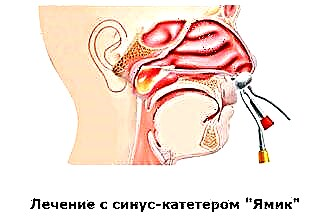Deformation of the nasal septum can be caused by congenital defects, as well as develop as a result of its traumatic injury. Most often, this pathological process is accompanied by a curvature of the nose or a change in its shape, which is characterized by aesthetic disturbances in appearance and adversely affects the social adaptation of such a patient.
 In addition, the curvature of the nasal septum is accompanied by impaired nasal breathing, which leads to the development of pathological conditions such as sinusitis, otitis media, frequent acute respiratory viral infections, neurological disorders, sleep disturbances, depression. In this regard, the operation to correct the nasal septum is a necessary measure in the fight against serious pathological conditions.
In addition, the curvature of the nasal septum is accompanied by impaired nasal breathing, which leads to the development of pathological conditions such as sinusitis, otitis media, frequent acute respiratory viral infections, neurological disorders, sleep disturbances, depression. In this regard, the operation to correct the nasal septum is a necessary measure in the fight against serious pathological conditions.
Since the development of these symptoms is due to the anatomical structure of the organ, the only method of helping such patients is surgery.
The nasal septum consists of bony structures and cartilage. Thus, depending on the location of the lesion, the operation to correct the nasal septum may include modeling the bone section, cartilage tissue, or be combined.
Surgical tactics
Depending on the severity of the process, the degree of curvature, technical capabilities, this intervention can proceed in the form
- septoplasty;
- laser correction.
Septoplasty consists in removing the deformed part of the cartilage, and, if necessary, the bony part of the septum.
They are straightened, modeled in a new way. This achieves a thinning of the cartilaginous area. It acquires elasticity, and this creates an opportunity for its alignment. Then the repaired part is returned to the desired position.
Different surgeons can use a different set of medical equipment and instruments. Currently, an increasing number of specialists are using an endoscope for this intervention. The use of such a powerful magnifying technique allows for a better view of the surgical field. This facilitates more accurate actions. This operation is called endoscopic septoplasty.
The complexity of this surgical intervention lies in the fact that its result is not always predictable. Despite the high-quality, professional technique of execution, there is always a risk of the need for repeated intervention. This is due to the desire of the modified cartilage to return to its original position.
In cases where intervention only on bone structures is expected, the likelihood of reoperation is much lower.
For example, an operation to reduce the nose can be carried out in the form of an osteotomy, when the destruction and subsequent removal of the bony part of the nasal septum occurs. Despite the significant volume of such intervention, the outcome of this operation is more favorable in terms of long-term prognosis.
Septoplasty is performed under local or general anesthesia.
The use of local anesthesia, although associated with less risk, is used only with minimal intervention. As for the operative access, open or endonasal, the necessary tactics are chosen by the surgeon and discussed with the patient. With a closed access, through the nostrils, the postoperative recovery period is faster and easier, the swelling of the paraorbital region and nose is less pronounced.
Endonasal surgery takes about 40 minutes. In this case, polyps and a sinus cyst can be removed at the same time. Within 24 hours after the operation, the nasal openings will be tamped with a special hygroscopic material. However, thanks to modern technology, such latex or gel tampons have built-in tubes that communicate with the external environment. Thus, breathing through the nose is not disturbed and can be carried out immediately after the operation.
Septoplasty differs from rhinoplasty in its indications. The operation to straighten the nasal septum is aimed at restoring the disturbed breathing, while the indication for rhinoplasty is the deformed outer shape of the nose. Often, the scope of surgical intervention in plastic surgery includes septoplasty.
Contraindications
 Septoplasty can be limited by a number of factors, such as:
Septoplasty can be limited by a number of factors, such as:
- the age of the patient;
- the presence of concomitant chronic diseases in the acute stage;
- existing pustular skin lesions in the area of the operation;
- the presence of diseases accompanied by a decrease in immunity;
- diabetes.
An important condition for the surgical intervention is the absence of acute respiratory diseases in the patient at the time of the operation. Since surgical intervention is associated with blood loss, in women, a relative contraindication for this operation is the period of menstruation.
Plastic surgery to change the shape of the nose is indicated only at the age of 20 to 40 years, when the osteochondral frame has already formed and, at the same time, there are no age-related changes. In addition, any chronic diseases lead to a decrease in immunity, and, therefore, lengthen the postoperative period, prevent the healing of the nose. Since anesthesia is used during the surgery, the satisfactory condition of the cardiovascular system is very important.
In cases where the main reason for performing septoplasty is a violation of nasal breathing, surgical intervention is performed when the child reaches the age of 14-16 years, in severe cases - from 6 years.
At the same time, its conduct in the elderly should be balanced, taking into account all potential complications.
In rare cases, surgery to straighten the nasal septum may be accompanied by the following complications:
- nose bleed;
- perforation of the nasal septum;
- change in the shape of the outer nose.
These are risks of a technical nature, the presence of which is due to the skills and experience of the operating surgeon.
Laser septoplasty
 The key to the success of the operation is to keep the mucous membrane intact. For this, they try to use only gentle manipulations.
The key to the success of the operation is to keep the mucous membrane intact. For this, they try to use only gentle manipulations.
The use of laser correction is the most gentle surgical treatment.
However, this method can only be used in very few patients.
Correction of the nasal septum with a laser can be carried out with deformations that are insignificant in area and nature.
In other cases, more extensive interventions are required. Operation with a curvature of the nasal septum using a laser implies a thermal effect on the cartilage. The high temperature of the laser radiation melts the cartilaginous tissue and turns it into a flexible pliable material. This allows the partition to be reshaped and returned to its original position.
The most positive result of laser exposure is the bloodlessness of such manipulation, the short time required for its implementation. As a result, the postoperative period is significantly shortened. The disadvantages of the method include the fact that the laser acts only on the cartilage, leaving the rest of the structure intact. At the same time, quite often during the operation, it is necessary to carry out the transformation of bone tissue.
Another disadvantage of using a laser is the too short period of use of this technique. Due to the fact that the thermal effect of this device is large, and there are no data on long-term results, then the use of this method may turn out to be dangerous in the long term. The cost of the operation carried out with the help of a laser device is also incomparably high in relation to other methods.
Operation on the nasal septum is an effective way to normalize the patient's condition, improve his nasal breathing. A timely surgical intervention will prevent the development of many pathological conditions.

 In cases where intervention only on bone structures is expected, the likelihood of reoperation is much lower.
In cases where intervention only on bone structures is expected, the likelihood of reoperation is much lower.

